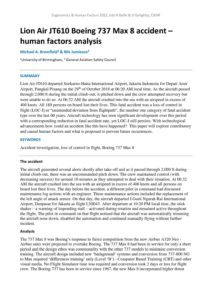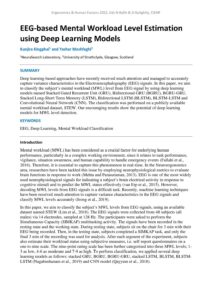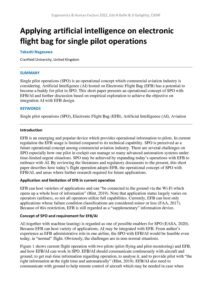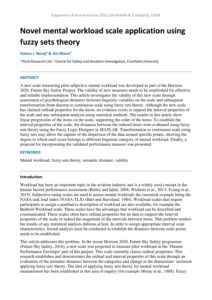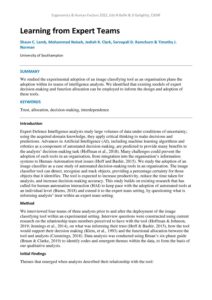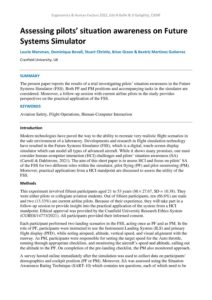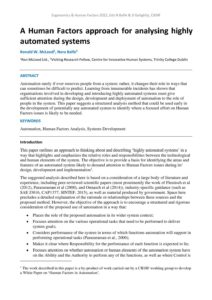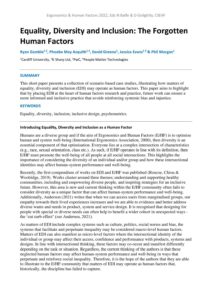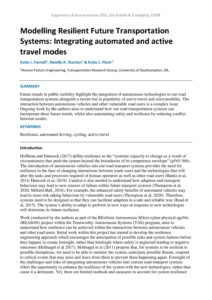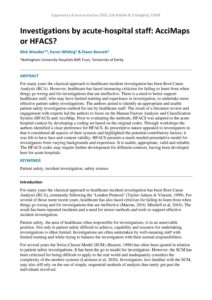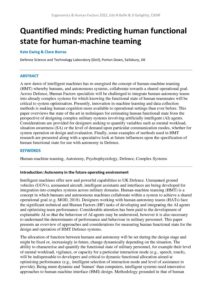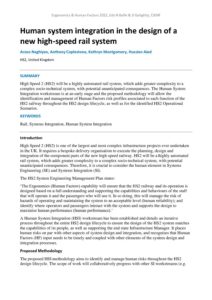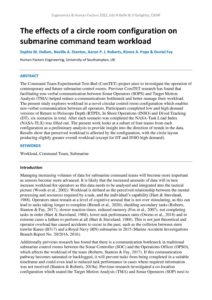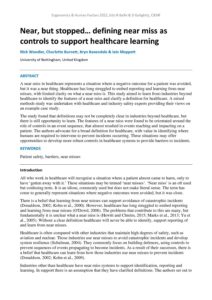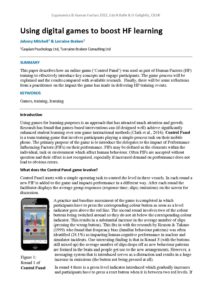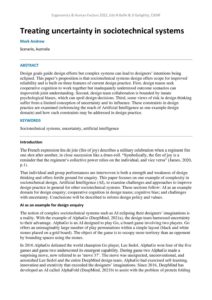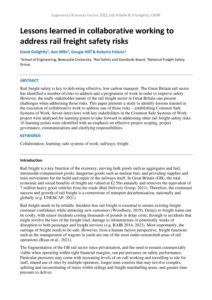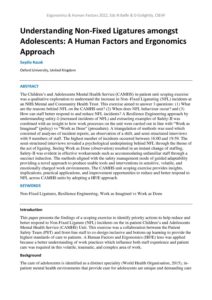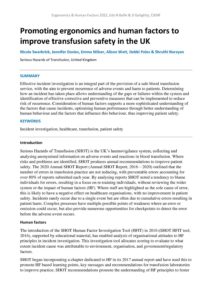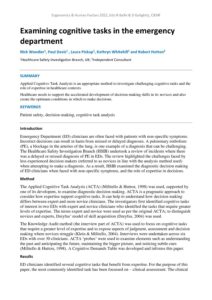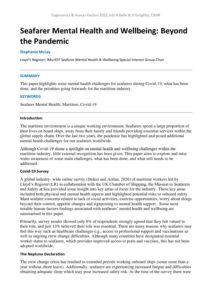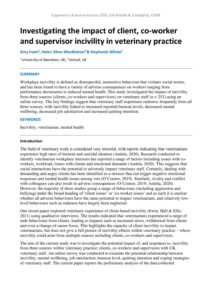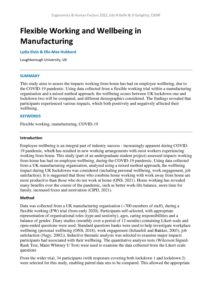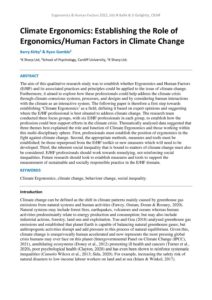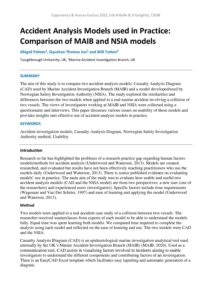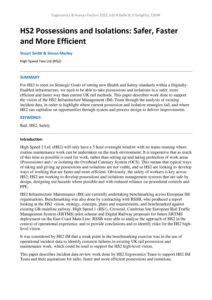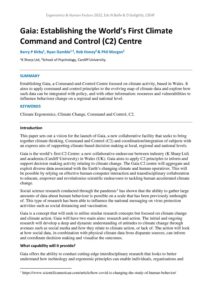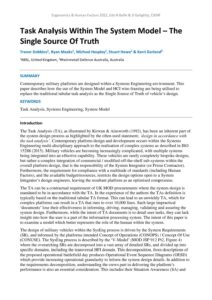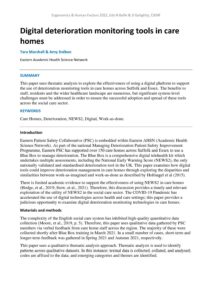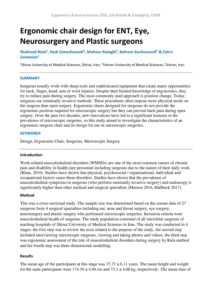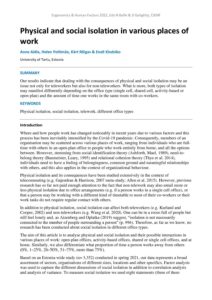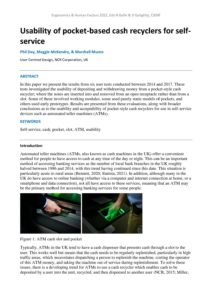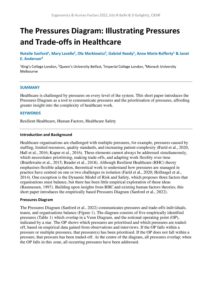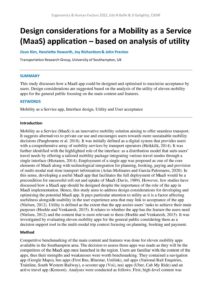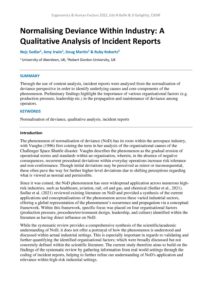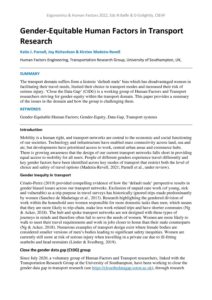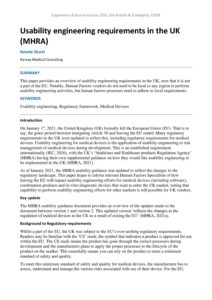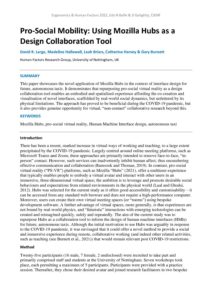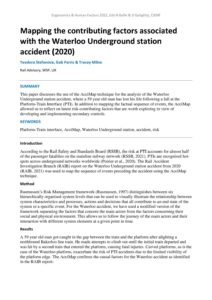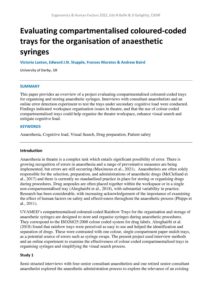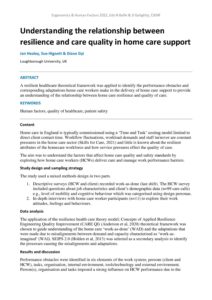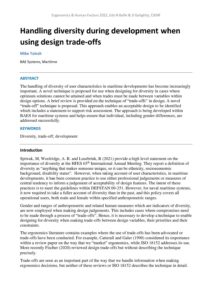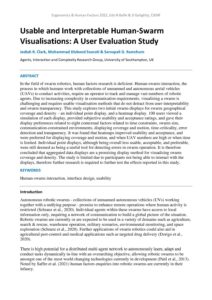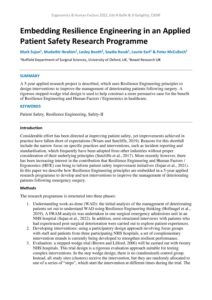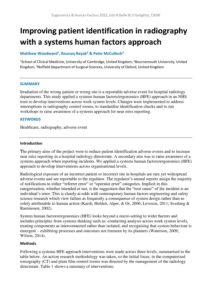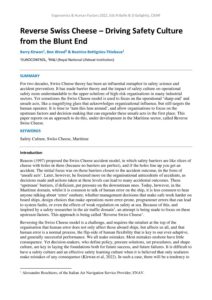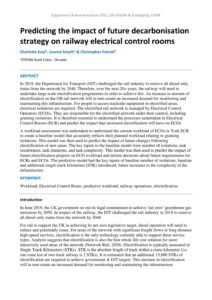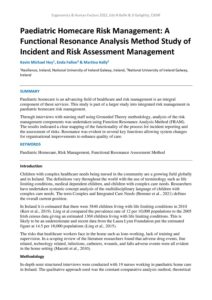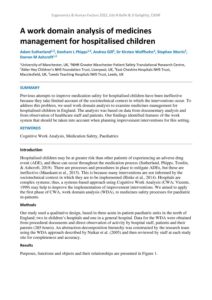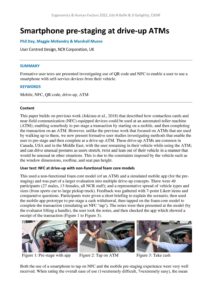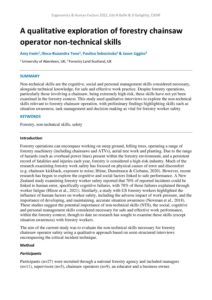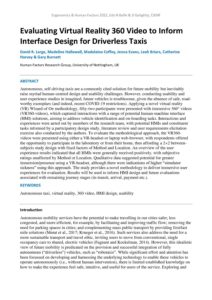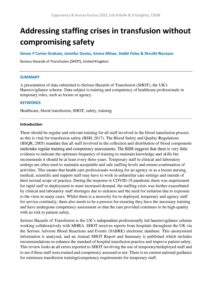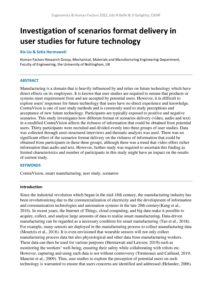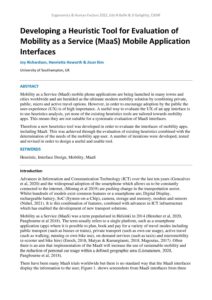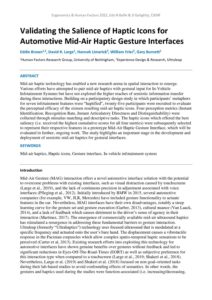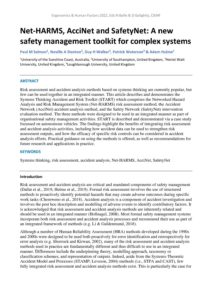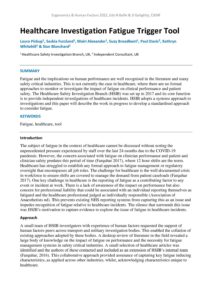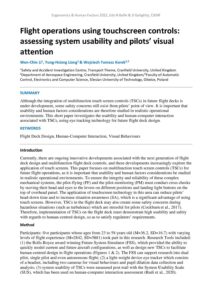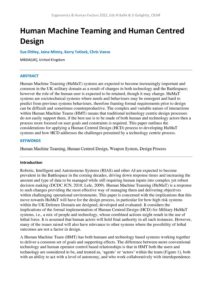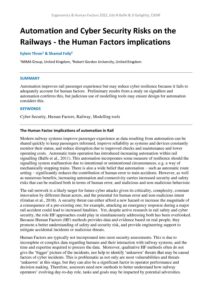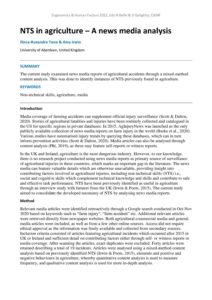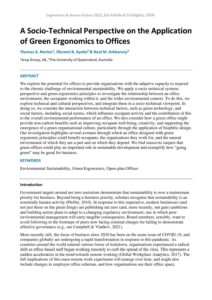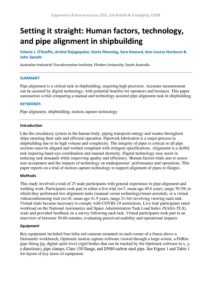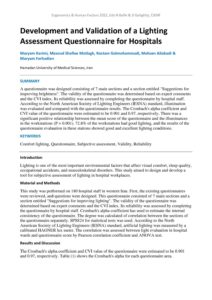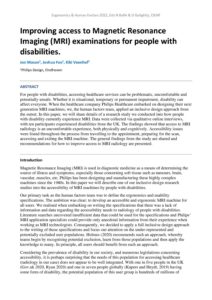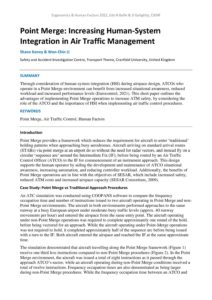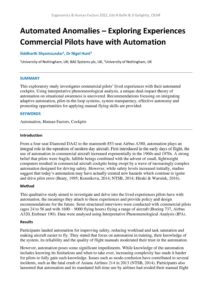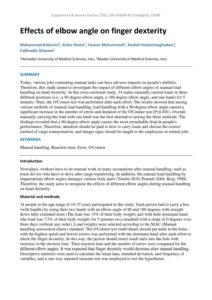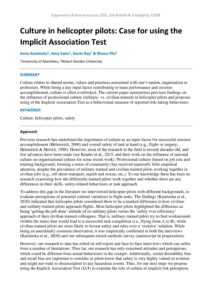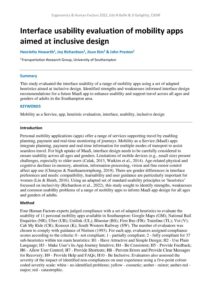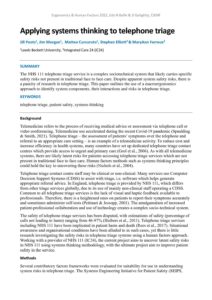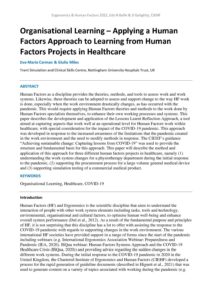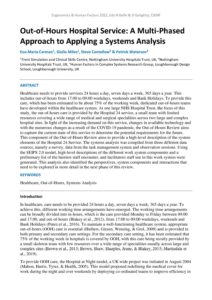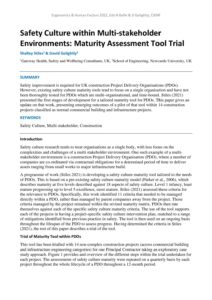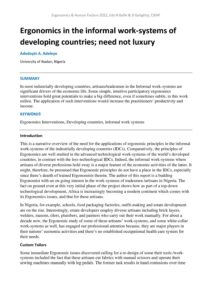Contemporary EHF 2022
Lion Air JT610 Boeing 737 Max 8 accident – human factors analysis
| Document | Author Michael A. Bromfield & Nils Jamieson |
| Abstract Lion Air JT610 departed Soekarno-Hatta International Airport, Jakarta Indonesia for Depati Amir Airport, Pangkal Pinang on the 29th of October 2018 at 06:20 AM local time. As the aircraft passed through 2,000 ft during the initial climb-out, it pitched down and the crew attempted recovery but were unable to do so. At 06:32 AM the aircraft crashed into the sea with an airspeed in excess of 400 knots. All 189 persons on board lost their lives. This fatal accident was a loss of control in flight (LOC-I) or “unintended deviation from flightpath”, the number one category of fatal accident type over the last 60 years. Aircraft technology has seen significant development over this period with a corresponding reduction in fatal accident rate, yet LOC-I still persists. With technological advancements how could an accident like this have happened? This paper will explore contributory and causal human factors and what is proposed to prevent future occurrences. |
EEG-based Mental Workload Level Estimation using Deep Learning Models
| Document | Author Kunjira Kingphai & Yashar Moshfeghi |
| Abstract Deep learning-based approaches have recently received much attention and managed to accurately capture variance characteristics in the Electroencephalography (EEG) signals. In this paper, we aim to classify the subject’s mental workload (MWL) level from EEG signal by using deep learning models named Stacked Gated Recurrent Unit (GRU), Bidirectional GRU (BGRU), BGRU-GRU, Stacked Long-Short Term Memory (LSTM), Bidirectional LSTM (BLSTM), BLSTM-LSTM and Convolutional Neural Network (CNN). The classification was performed on a publicly available mental workload dataset, STEW. Our encouraging results show the potential of deep learning models for MWL level detection. |
Applying artificial intelligence on electronic flight bag for single pilot operations
| Document | Author Takashi Nagasawa |
| Abstract Single pilot operations (SPO) is an operational concept which commercial aviation industry is considering. Artificial Intelligence (AI) hosted on Electronic Flight Bag (EFB) has a potential to become a buddy for pilot in SPO. This short paper presents an operational concept of SPO with EFB/AI and further discussion based on empirical exploration to achieve the objective on integration AI with EFB design. |
Novel mental workload scale application using fuzzy sets theory
| Document | Author Hanna J. Neroj & Jim Nixon |
| Abstract A new scale measuring pilot subjective mental workload was developed as part of the Horizon 2020, Future Sky Safety Project: The validity of new measures needs to be established for effective and reliable implementation. This article investigates the validity of this new scale through assessment of psychological distances between linguistic variables on the scale and subsequent transformation from discrete to continuous scale using fuzzy sets theory. Although the new scale has claimed ordinal properties for the items, no evidence exists to support the interval properties of the scale and any subsequent analysis using statistical methods. The results in this article show linear progression of the items on the scale, supporting the order of the items. To establish the interval properties of the scale, the distances between the ordered items were evaluated using fuzzy sets theory using the Fuzzy Logic Designer in MATLAB. Transformation to continuous scale using fuzzy sets may allow the capture of the dispersion of the data around specific points, showing the degree to which each score belongs to different linguistic category of mental workload. Finally, a proposal for incorporating the validated performance measure was presented. |
Learning from Expert Teams
| Document | Author Shaun C. Lamb, Mohammad Naiseh, Jediah R. Clark, Sarvapali D. Ramchurn & Timothy J. Norman |
| Abstract We studied the experimental adoption of an image classifying tool as an organisation plans the adoption within its teams of intelligence analysts. We identified that existing models of expert decision-making and function allocation can be employed to inform the design and adoption of these tools. |
Assessing pilots’ situation awareness on Future Systems Simulator
| Document | Author Laurie Marsman, Dominique Bovell, Stuart Christie, Brian Green & Beatriz Martinez Gutierrez |
| Abstract The present paper reports the results of a trial investigating pilots’ situation awareness in the Future Systems Simulator (FSS). Both PF and PM positions and accompanying tasks in the simulator are considered. Moreover, a follow-up session with current airline pilots in the study provides perspectives on the practical application of the FSS. |
A Human Factors approach for analysing highly automated systems
| Document | Author Ronald W. McLeod & Nora Balfe |
| Abstract Automation rarely if ever removes people from a system: rather, it changes their role in ways that can sometimes be difficult to predict. Learning from innumerable incidents has shown that organisations involved in developing and introducing highly automated systems must give sufficient attention during the design, development and deployment of automation to the role of people in the system. This paper suggests a structured analysis method that could be used early in the development of potentially any automated system to identify where a focused effort on Human Factors issues is likely to be needed. |
Equality, Diversity and Inclusion: The Forgotten Human Factors
| Document | Author Ryan Gamble, Phoebe May Asquith1, David Greeno, Jessica Evans & Phil Morgan |
| Abstract This short paper presents a collection of scenario-based case studies, illustrating how matters of equality, diversity and inclusion (EDI) may operate as human factors. This paper aims to highlight that by placing EDI at the heart of human factors research and practice, future work can ensure a more informed and inclusive practice that avoids reinforcing systemic bias and injustice. |
Modelling Resilient Future Transportation Systems: Integrating automated and active travel modes
| Document | Author Katie J. Parnell, Neville A. Stanton & Katie L. Plant |
| Abstract Future trends in public mobility highlight the integration of autonomous technologies to our road transportation systems alongside a recent rise in popularity of active travel and micromobility. The interaction between autonomous vehicles and other vulnerable road users is a complex issue. Ongoing work by the authors aims to understand how our road transportation systems can incorporate these future trends, whilst also maintaining safety and resilience by reducing conflict between modes. |
Investigations by acute-hospital staff: AcciMaps or HFACS?
| Document | Author Nick Woodier, Karen Whiting & Owen Bennett |
| Abstract For many years the classical approach to healthcare incident investigation has been Root Cause Analysis (RCA). However, healthcare has faced increasing criticism for failing to learn from when things go wrong and for investigations that are ineffective. There is a need to better support healthcare staff, who may have limited training and experience in investigation, to undertake more effective patient safety investigations. The authors aimed to identify an appropriate and usable patient safety investigation method for use by healthcare staff. The result of a literature review and engagement with experts led the authors to focus on the Human Factors Analysis and Classification System (HFACS) and AcciMap. Prior to evaluating the methods, HFACS was adapted to the acute hospital context by developing a coding set based on the original codes. Through workshops the authors identified a clear preference for HFACS. Its prescriptive nature appealed to investigators in that it considered all aspects of their systems and highlighted the potential contributory factors; it was felt to have face and content validity. HFACS presents a much-needed prescriptive model for investigators from varying backgrounds and experience. It is usable, appropriate, valid and reliable. The HFACS codes may require further development for different contexts, having been developed here for acute hospitals. |
Quantified minds: Predicting human functional state for human-machine teaming
| Document | Author Kate Ewing & Clare Borras |
| Abstract A new dawn of intelligent machines has re-energised the concept of human-machine teaming (HMT) whereby humans, and autonomous systems, collaborate towards a shared operational goal. Across Defence, Human Factors specialists will be challenged to integrate human-autonomy teams into already complex systems for which knowing the functional state of human teammates will be critical to system optimisation. Presently, innovation in machine learning and data collection methods is making human cognition more available to operational settings than ever before. This paper overviews the state of the art in techniques for estimating human functional state from the perspective of designing complex military systems involving artificially intelligent (AI) agents. Considerations are provided for designers seeking to quantify variables such as mental workload, situation awareness (SA) or the level of demand upon particular communication modes, whether for system operation or design and evaluation. Finally, some examples of methods used in HMT research are presented along with a speculative look at future influences upon the specification of human functional state for use with autonomy in Defence. |
Human system integration in the design of a new high-speed rail system
| Document | Author Arzoo Naghiyev, Anthony Coplestone, Kathryn Montgomery & Hussien Aied |
| Abstract High Speed 2 (HS2) will be a highly automated rail system, which adds greater complexity to a complex socio-technical system, with potential unanticipated consequences. The Human System Integration workstream is at an early stage and the proposed methodology will allow the identification and management of Human Factors risk profiles associated to each function of the HS2 railway throughout the HS2 design lifecycle, as well as for the identified HS2 Operational Scenarios. |
The effects of a circle room configuration on submarine command team workload
| Document | Author Sophie M. Hallam, Neville A. Stanton, Aaron P. J. Roberts, Kiome A. Pope & Daniel Fay |
| Abstract The Command Team Experimental Test-Bed (ComTET) project aims to investigate the operation of contemporary and future submarine control rooms. Previous ComTET research has found that facilitating non-verbal communication between Sonar Operators (SOPS) and Target Motion Analysts (TMA) helped reduce a communications bottleneck and better manage their workload. The present study explores workload in a novel circular control room configuration which enables non-verbal communication between all operators. Participants completed low and high demand versions of Return to Periscope Depth (RTPD), In Shore Operations (INSO) and Dived Tracking (DT), six scenarios in total. After each scenario was completed the NASA-Task Load Index (NASA-TLX) was filled out. The present work looks at a subset of four teams from each configuration as a preliminary analysis to provide insight into the direction of trends in the data. Results show that perceived workload is affected by the configuration, with the circle layout producing slightly greater overall workload (except for DT and INSO high demand). |
Near, but stopped… defining near miss as controls to support healthcare learning
| Document | Author Nick Woodier, Charlotte Burnett, Bryn Baxendale & Iain Moppett |
| Abstract A near miss in healthcare represents a situation where a negative outcome for a patient was avoided, but it was a near thing. Healthcare has long struggled to embed reporting and learning from near misses, with limited clarity on what a near miss is. This study aimed to learn from industries beyond healthcare to identify the features of a near miss and clarify a definition for healthcare. A mixed methods study was undertaken with healthcare and industry safety experts providing their views on an example case study. The study found that definitions may not be completely clear in industries beyond healthcare, but there is still opportunity to learn. The features of a near miss were found to be orientated around the role of controls in an event sequence, that almost resulted in events reaching and impacting on a patient. The authors advocate for a broad definition for healthcare, with value in identifying where humans are required to intervene to prevent incidents occurring. These situations may offer opportunities to develop more robust controls in healthcare systems to provide barriers to incidents. |
Using digital games to boost HF learning
| Document | Author Johnny Mitchell & Lorraine Braben |
| Abstract This paper describes how an online game (‘Control Panel’) was used as part of Human Factors (HF) training to effectively introduce key concepts and engage participants. The game process will be explained and the results compared with available research. Finally, there will be some reflections from a practitioner on the impact the game has made in delivering HF training events. |
Treating uncertainty in sociotechnical systems
| Document | Author Mark Andrew |
| Abstract Design goals guide design efforts but complex systems can lead to designers’ intentions being eclipsed. This paper’s proposition is that sociotechnical systems design offers scope for improved reliability and is built on three features of current design practice. First, design teams seek cooperative cognition to work together but inadequately understood outcome scenarios can impoverish joint understanding. Second, design team collaboration is bounded by innate psychological biases, which can spoil design decisions. Third, some views of risk in design thinking suffer from a limited conception of uncertainty and its influence. These constraints in design practice are examined (referencing the reach of Artificial Intelligence as one example design domain) and how such constraints may be addressed in design practice. |
Lessons learned in collaborative working to address rail freight safety risks
| Document | Author David Golightly, Ann Mills, Dougie Hill & Roberto Palacin |
| Abstract Rail freight safety is key to delivering effective, low carbon transport. The Great Britain rail sector has identified a number of risks to address and a programme of work in order to improve safety. However, the multi-stakeholder nature of the rail freight sector in Great Britain can present challenges when addressing those risks. This paper presents a study to identify lessons learned in the execution of collaborative work to address one of those risks – establishing Common Safe Systems of Work. Seven interviews with key stakeholders in the Common Safe Systems of Work project were analysed for learning points to take forward in addressing other rail freight safety risks. 16 learning points were identified with an emphasis on effective project scoping, project governance, communications and clarifying responsibilities. |
Understanding Non-Fixed Ligatures amongst Adolescents: A Human Factors and Ergonomics Approach
| Document | Author Saydia Razak |
| Abstract The Children’s and Adolescents Mental Health Service (CAMHS) in-patient unit scoping exercise was a qualitative exploration to understand the increase in Non–Fixed Ligaturing (NFL) incidents at an NHS Mental and Community Health Trust. This exercise aimed to answer 3 questions: (1) What are the reasons behind NFL on the CAMHS unit? (2) When does NFL behaviour occur? and (3) How can staff better respond to and reduce NFL incidents? A Resilience Engineering approach by understanding safety-I (increased incidents of NFL) and extracting examples of Safety-II was combined with an insight to how work processes on the unit were carried out in line with “Work as Imagined” (policy) vs “Work as Done” (procedure). A triangulation of methods was used which consisted of analyses of incident reports, an observation of a shift, and semi-structured interviews with 9 members of staff. The highest number of incidents occurred between 16:00 and 19:59. The semi-structured interviews revealed a psychological underpinning behind NFL through the theme of the act of ligating. Seeing Work as Done (observation) resulted in an instant change of staffing. Safety-II was evident in effective workarounds such as accommodating unfamiliar staff through a succinct induction. The methods aligned with the safety management mode of guided adaptability providing a novel approach to produce usable tools and interventions in sensitive, volatile, and emotionally charged work environments. The CAMHS unit scoping exercise provides insights, implications, practical applications, and improvement opportunities to reduce and better respond to NFL across CAMHS units by adopting a HF/E approach. |
Promoting ergonomics and human factors to improve transfusion safety in the UK
| Document | Author Nicola Swarbrick, Jennifer Davies, Emma Milser, Alison Watt, Debbi Poles & Shruthi Narayan |
| Abstract Effective incident investigation is an integral part of the provision of a safe blood transfusion service, with the aim to prevent recurrence of adverse events and harm to patients. Determining how an incident has taken place allows understanding of the gaps or failures within the system and identification of effective corrective and preventive measures that can be implemented to reduce risk of recurrence. Consideration of human factors supports a more sophisticated understanding of the factors that cause incidents, optimising human performance through better understanding of human behaviour and the factors that influence this behaviour, thus improving patient safety. |
Examining cognitive tasks in the emergency department
| Document | Author Nick Woodier, Paul Davis, Laura Pickup, Kathryn Whitehill & Robert Hutton |
| Abstract Applied Cognitive Task Analysis is an appropriate method to investigate challenging cognitive tasks and the role of expertise in healthcare contexts. Healthcare needs to support the accelerated development of decision-making skills in its novices and also create the optimum conditions in which to make decisions. |
Seafarer Mental Health and Wellbeing: Beyond the Pandemic
| Document | Author Stephanie McLay |
| Abstract This paper highlights some mental health challenges for seafarers during Covid-19, what has been done, and the priorities going forwards for the maritime industry. |
Investigating the impact of client, co-worker and supervisor incivility in veterinary practice
| Document | Author Amy Irwin, Helen Silver-MacMahon & Stephanie Wilcke |
| Abstract Workplace incivility is defined as disrespectful, insensitive behaviour that violates social norms, and has been found to have a variety of adverse consequences on workers ranging from performance decrements to reduced mental health. This study investigated the impact of incivility from three sources (clients, co-workers and supervisors) on veterinary staff (n = 252) using an online survey. The key findings suggest that veterinary staff experience rudeness frequently from all three sources, with incivility linked to increased reported burnout levels, decreased mental wellbeing, decreased job satisfaction and increased quitting intention. |
Flexible Working and Wellbeing in Manufacturing
| Document | Author Lydia Elvin & Ella-Mae Hubbard |
| Abstract This study aims to assess the impacts working from home has had on employee wellbeing, due to the COVID-19 pandemic. Using data collected from a flexible working trial within a manufacturing organisation and a mixed method approach, the wellbeing scores between UK lockdown one and lockdown two will be compared, and different demographics considered. The findings revealed that participants experienced various impacts, which both positively and negatively affected their wellbeing. |
Climate Ergonomics: Establishing the Role of Ergonomics/Human Factors in Climate Change
| Document | Author Barry Kirby & Ryan Gamble |
| Abstract The aim of this qualitative research study was to establish whether Ergonomics and Human Factors (E/HF) and its associated practices and principles could be applied to the issue of climate change. Furthermore, it aimed to explore how these professionals could help address the climate crisis through climate-conscious systems, processes, and designs and by considering human interactions with the climate as an interactive system. The following paper is therefore a first step towards establishing ‘Climate Ergonomics’ as a field, defining it based on expert opinions and suggesting where the E/HF professional is best situated to address climate change. The research team conducted three focus groups, with six E/HF professionals in each group, to establish how the profession could best support efforts in the climate crisis. Thematically analysed data suggested that three themes best explained the role and function of Climate Ergonomics and those working within this multi-disciplinary sphere. First, professionals must establish the position of ergonomics in the fight against climate change. Second, the appropriate methods, measures and tools must be established; be those repurposed from the E/HF toolkit or new measures which will need to be developed. Third, the inherent social inequality that is bound to matters of climate change must also be considered. E/HF professionals should work towards remedying, not reinforcing social inequalities. Future research should look to establish measures and tools to support the measurement of sustainable and socially responsible practice in the E/HF domain. |
Accident Analysis Models used in Practice: Comparison of MAIB and NSIA models
| Document | Author Abigail Palmer, Gyuchan Thomas Jun & Will Tutton |
| Abstract The aim of this study is to compare two accident analysis models: Casualty Analysis Diagram (CAD) used by Marine Accident Investigation Branch (MAIB) and a model developed/used by Norwegian Safety Investigation Authority (NSIA). The study explored the similarities and differences between the two models when applied to a real marine accident involving a collision of two vessels. The views of investigators working at MAIB and NSIA were collected using a questionnaire and interviews. This paper discusses various issues on usability of these models and provides insights into effective use of accident analysis models in practice. |
HS2 Possessions and Isolations: Safer, Faster and More Efficient
| Document | Author Stuart Smith & Simon Morley |
| Abstract For HS2 to meet its Strategic Goals of setting new Health and Safety standards within a Digitally-Enabled infrastructure, we need to be able to take possessions and isolations in a safer, more efficient and faster way than current UK rail methods. This paper describes work done to support the vision of the HS2 Infrastructure Management (IM) Team through the analysis of existing incident data, in order to highlight where current possession and isolation strategies fail, and where HS2 can capitalise on opportunities through system and process design to deliver improvements. |
Gaia: Establishing the World’s First Climate Command and Control (C2) Centre
| Document | Author Barry P Kirby, Ryan Gamble, Rob Honey & Phil Morgan |
| Abstract Establishing Gaia, a Command-and-Control Centre focused on climate activity, based in Wales. It aims to apply command and control principles to the evolving map of climate data and explore how such data can be integrated with policy, and with other information: resources and vulnerabilities to influence behaviour change on a regional and national level. |
Task Analysis Within The System Model – The Single Source Of Truth
| Document | Author Trevor Dobbins, Ryan Meeks, Michael Hespley, Stuart Howe & Kerri Garland |
| Abstract Contemporary military platforms are designed within a Systems Engineering environment. This paper describes how the use of the System Model and HCI wire-framing are being utilised to replace the traditional tabular task analysis as the Single Source of Truth of vehicle’s design. |
Digital deterioration monitoring tools in care homes
| Document | Author Tara Marshall & Amy Dolben |
| Abstract This paper uses thematic analysis to explore the effectiveness of using a digital platform to support the use of deterioration monitoring tools in care homes across Suffolk and Essex. The benefits to staff, residents and the wider healthcare landscape are numerous, but significant system-level challenges must be addressed in order to ensure the successful adoption and spread of these tools across the social care sector. |
Ergonomic chair design for ENT, Eye, Neurosurgery and Plastic surgeons
| Document | Author Shahrzad Riaei, Hadi Daneshmandi, Mohsen Razeghi, Bahram Kouhnavard & Zahra Zamanian |
| Abstract Surgeons usually work with sharp tools and sophisticated equipment that create many opportunities for neck, finger, hand, arm or wrist injuries. Despite their limited knowledge of ergonomics, they try to reduce pain during surgery. The most commonly used approach is position change. Today, surgeons use minimally invasive methods. These procedures often impose more physical needs on the surgeon than open surgery. Ergonomic chairs designed for surgeons do not provide the ergonomic position required for microscopic surgery but they can prevent back pain during open surgery. Over the past two decades, new innovations have led to a significant increase in the prevalence of microscopic surgeries, so this study aimed to investigate the characteristics of an ergonomic surgeon chair and its design for use in microscopic surgeries. |
Physical and social isolation in various places of work
| Document | Author Anne Aidla, Helen Poltimäe, Kärt Rõigas & Eneli Kindsiko |
| Abstract Our results indicate that dealing with the consequences of physical and social isolation may be an issue not only for teleworkers but also for non-teleworkers. What is more, both types of isolation may manifest differently depending on the office type (single cell, shared cell, activity-based or open-plan) and the amount of time one works in the same room with co-workers. |
Usability of pocket-based cash recyclers for self-service
| Document | Author Phil Day, Maggie McKendry & Marshall Munro |
| Abstract In this paper we present the results from six user tests conducted between 2014 and 2017. These tests investigated the usability of depositing and withdrawing money from a pocket-style cash recycler; where the notes are inserted into and removed from an open receptacle rather than from a slot. Some of these involved working modules, some used purely static models of pockets, and others used early prototypes. Results are presented from these evaluations, along with broader conclusions as to the usability and acceptability of pocket-style cash recyclers for use in self-service devices such as automated teller machines (ATMs). |
The Pressures Diagram: Illustrating Pressures and Trade-offs in Healthcare
| Document | Author Natalie Sanford, Mary Lavelle, Ola Markiewicz, Gabriel Reedy, Anne Marie Rafferty & Janet E. Anderson |
| Abstract Healthcare is challenged by pressures on every level of the system. This short paper introduces the Pressures Diagram as a tool to communicate pressures and the prioritisation of pressures, affording greater insight into the complexity of healthcare work. |
Design considerations for a Mobility as a Service (MaaS) application – based on analysis of utility
| Document | Author Jisun Kim, Henrietta Howarth, Joy Richardson & John Preston |
| Abstract This study discusses how a MaaS app could be designed and optimised to maximise acceptance by users. Design considerations are suggested based on the analysis of the utility of eleven mobility apps for the general public focusing on the main content and features. |
Normalising Deviance Within Industry: A Qualitative Analysis of Incident Reports
| Document | Author Nejc Sedlar, Amy Irwin, Doug Martin & Ruby Roberts |
| Abstract Through the use of content analysis, incident reports were analysed from the normalisation of deviance perspective in order to identify underlying causes and core components of the phenomenon. Preliminary findings highlight the importance of various organisational factors (e.g. production pressure, leadership etc.) in the propagation and maintenance of deviance among operators. |
Gender-Equitable Human Factors in Transport Research
| Document | Author Katie J. Parnell, Joy Richardson & Kirsten Madeira-Revell |
| Abstract The transport domain suffers from a historic ‘default male’ bias which has disadvantaged women in facilitating their travel needs, limited their choice in transport modes and increased their risk of serious injury. ‘Close the Data Gap’ (CtDG) is a working group of Human Factors and Transport researchers striving for gender-equity within the transport domain. This paper provides a summary of the issues in the domain and how the group is challenging them. |
Usability engineering requirements in the UK (MHRA)
| Document | Author Natalie Shortt |
| Abstract This paper provides an overview of usability engineering requirements in the UK, now that it is not a part of the EU. Notably, Human Factors vendors do not need to be local to any region to perform usability engineering activities, but human factors processes need to adhere to local requirements. |
Pro-Social Mobility: Using Mozilla Hubs as a Design Collaboration Tool
| Document | Author David R. Large, Madeline Hallewell, Leah Briars, Catherine Harvey & Gary Burnett |
| Abstract This paper showcases the novel application of Mozilla Hubs in the context of interface design for future, autonomous taxis. It demonstrates that repurposing pro-social virtual reality as a design collaboration tool enables an embodied and spatialised experience affording the co-creation and visualisation of novel interfaces, scaffolded by real-world social dynamics, but unfettered by its physical limitations. The approach has proved to be beneficial during the COVID-19 pandemic, but it also provides genuine opportunity for virtual, “non-contact” collaborative research beyond this. |
Advancing a Social Licence to Operate for improved evacuation of cruise ships
| Document | Author Paul Liston, Alison M Kay & Emma Delemere |
| Abstract The development of technologies for improved evacuations of large cruise ships necessitates a sociotechnical approach to requirements elicitation, technology development activities, and the evaluation of the solutions produced. The concept of Social Licence to Operate (SLO) offers the opportunity to address concerns around ethics, regulations and de-skilling in planning for implementation and operation. This paper outlines the approach taken in advancing this SLO. |
Mapping the contributing factors associated with the Waterloo Underground station accident (2020)
| Document | Author Teodora Stefanova, Gab Parris & Tracey Milne |
| Abstract This paper discusses the use of the AcciMap technique for the analysis of the Waterloo Underground station accident, where a 59 year old man has lost his life following a fall at the Platform-Train Interface (PTI). In addition to mapping the factual sequence of events, the AcciMap allowed us to reflect on latent risk-contributing factors that are worth exploring in view of developing and implementing secondary controls. |
Evaluating compartmentalised coloured-coded trays for the organisation of anaesthetic syringes
| Document | Author Victoria Laxton, Edward J.N. Stupple, Frances Maratos & Andrew Baird |
| Abstract This paper provides an overview of a project evaluating compartmentalised coloured-coded trays for organising and storing anaesthetic syringes. Interviews with consultant anaesthetists and an online error detection experiment to test the trays under secondary cognitive load were conducted. Findings indicated workspace organisation issues in theatre, and that the use of colour-coded compartmentalised trays could help organise the theatre workspace, enhance visual search and mitigate cognitive load. |
Understanding the relationship between resilience and care quality in home care support
| Document | Author Jan Healey, Sue Hignett & Diane Gyi |
| Abstract A resilient healthcare theoretical framework was applied to identify the performance obstacles and corresponding adaptations home care workers make in the delivery of home care support to provide an understanding of the relationship between home care resilience and quality of care. |
Handling diversity during development when using design trade-offs
| Document | Author Mike Tainsh |
| Abstract The handling of diversity of user characteristics in maritime developments has become increasingly important. A novel technique is proposed for use when designing for diversity in cases where optimum solutions cannot be attained and when trades must be made between variables within design options. A brief review is provided on the technique of “trade-offs” in design. A novel “trade-off” technique is proposed. This approach enables an acceptable design to be identified which includes a statement to support risk assessment. The approach is being developed within BAES for maritime systems and helps ensure that individual, including gender differences, are addressed successfully. |
Usable and Interpretable Human-Swarm Visualisations: A User Evaluation Study
| Document | Author Jediah R. Clark, Mohammad Divband Soorati & Sarvapali D. Ramchurn |
| Abstract In the field of swarm robotics, human factors research is deficient. Human-swarm interaction, the process in which humans work with collections of unmanned and autonomous aerial vehicles (UAVs) to conduct activities, require an operator to track and manage vast numbers of robotic agents. Due to increasing complexity in communication requirements, visualising a swarm is challenging and requires usable visualisation methods that do not detract from user-interpretability and swarm transparency. This study explores two initial swarm-displays for swarm geographical coverage and density – an individual point display, and a heatmap display. 100 users viewed a simulation of each display, provided subjective usability and acceptance ratings, and gave their display preferences related to eight contextual factors related to time constraints, swarm size, communication-constrained environments, displaying coverage and motion, time-criticality, error detection and transparency. It was found that heatmaps improved usability and acceptance, and were preferred for displaying coverage and motion, and when UAV numbers are high or when time is limited. Individual point displays, although being overall less usable, acceptable, and preferable, were still deemed as being a useful tool for detecting errors in swarm operation. It is therefore concluded that aggregated data displays are a promising display method for visualising swarm coverage and density. The study is limited due to participants not being able to interact with the displays, therefore further research is required to further test the effects reported in this study. |
Embedding Resilience Engineering in an Applied Patient Safety Research Programme
| Document | Author Mark Sujan, Mudathir Ibrahim, Lesley Booth, Saydia Razak, Laurie Earl & Peter McCulloch |
| Abstract A 5-year applied research project is described, which uses Resilience Engineering principles to design interventions to improve the management of deteriorating patients following surgery. A rigorous stepped-wedge trial design is used to help construct a more persuasive case for the benefit of Resilience Engineering and Human Factors / Ergonomics in healthcare. |
Improving patient identification in radiography with a systems human factors approach
| Document | Author Matthew Woodward, Rounaq Nayak & Peter McCulloch |
| Abstract Irradiation of the wrong patient or wrong site is a reportable adverse event for hospital radiology departments. This study applied a systems human factors/ergonomics (HFE) approach in an NHS trust to develop interventions across work system levels. Changes were implemented to address interruptions in radiography control rooms, to standardise identification checks and to run workshops to raise awareness of a systems approach for near miss reporting. |
Reverse Swiss Cheese – Driving Safety Culture from the Blunt End
| Document | Author Barry Kirwan, Ben Wood & Beatrice Bettignies-Thiebaux |
| Abstract For two decades, Swiss Cheese theory has been an influential metaphor in safety science and accident prevention. It has made barrier theory and the impact of safety culture on operational safety more understandable to the upper echelons of high-risk organisations in many industrial sectors. Yet sometimes the Swiss Cheese model is used to focus on the operational ‘sharp end’ and unsafe acts, like a magnifying glass that acknowledges organizational influence, but still targets the human operator. It is time to ‘turn this lens around’, and allow organisations to focus on the upstream factors and decision-making that can engender these unsafe acts in the first place. This paper reports on an approach to do this, under development in the Maritime sector, called Reverse Swiss Cheese. |
Predicting the impact of future decarbonisation strategy on railway electrical control rooms
| Document | Author Charlotte Kaul, Joanne Smyth & Christopher Patrick |
| Abstract In 2018, the Department for Transport (DfT) challenged the rail industry to remove all diesel-only trains from the network by 2040. Therefore, over the next 20+ years, the railway will need to undertake large scale electrification programmes in order to achieve this. An increase in amount of electrification on the GB rail network will in turn create an increased demand for monitoring and maintaining this infrastructure. For people to access trackside equipment in electrified areas, electrical isolations are required. The electrified rail network is managed by Electrical Control Operators (ECOs). They are responsible for the electrified network under their control, including granting isolations. It is therefore essential to understand the processes undertaken in Electrical Control Rooms (ECR) and predict the impact that increased electrification will have on ECOs. A workload assessment was undertaken to understand the current workload of ECOs in York ECR to create a baseline model that accurately reflects their planned workload relating to granting isolations. This model was then used to predict the impact of future changes following electrification of new areas. The key inputs to the baseline model were number of isolations, task occurrences, task durations, and task complexity. This model was then used to predict the impact of future electrification projects on ECO workload and inform decisions about future requirements for ECRs and ECOs. The predictive model had the key inputs of baseline number of isolations, baseline and additional single-track kilometres (STK) introduced, future increases to the complexity of the infrastructure. |
Paediatric Homecare Risk Management: A Functional Resonance Analysis Method Study of Incident and Risk Assessment Management
| Document | Author Kevin Michael Hoy, Enda Fallon & Martina Kelly |
| Abstract Paediatric homecare is an advancing field of healthcare and risk management is an integral component of these services. This study is part of a larger study into integrated risk management in paediatric homecare risk management. Through interviews with nursing staff using Grounded Theory methodology, analysis of the risk management components was undertaken using Function Resonance Analysis Method (FRAM). The results indicated a clear mapping of the functionality of the process for incident reporting and the assessment of risks. Resonance was evident in several key functions allowing system changes for organisational improvements to enhance quality of care. KEYWORDS |
A work domain analysis of medicines management for hospitalised children
| Document | Author Adam Sutherland, Denham L Phipps, Andrea Gill, Dr Kirsten Wolffsohn, Stephen Morris & Darren M Ashcroft |
| Abstract Previous attempts to improve medication safety for hospitalised children have been ineffective because they take limited account of the sociotechnical context in which the interventions occur. To address this problem, we used work domain analysis to examine medicines management for hospitalised children in England. The analysis was based on data from documentary analysis and from observation of healthcare staff and patients. Our findings identified features of the work system that should be taken into account when planning improvement interventions for this setting. |
Smartphone pre-staging at drive-up ATMs
| Document | Author Phil Day, Maggie McKendry & Marshall Munro |
| Abstract Formative user tests are presented investigating use of QR code and NFC to enable a user to use a smartphone with self-service devices from their vehicle. |
A qualitative exploration of forestry chainsaw operator non-technical skills
| Document | Author Amy Irwin1, Ilinca-Ruxandra Tone, Paulina Sobocinska & Jason Liggins |
| Abstract Non-technical skills are the cognitive, social and personal management skills considered necessary, alongside technical knowledge, for safe and effective work practice. Despite forestry operations, particularly those involving a chainsaw, being extremely high-risk, these skills have not yet been examined in the forestry context. This study used qualitative interviews to explore the non-technical skills relevant to forestry chainsaw operation, with preliminary findings highlighting skills such as situation awareness, task management and decision-making as vital for forestry worker safety. |
Evaluating Virtual Reality 360 Video to Inform Interface Design for Driverless Taxis
| Document | Author David R. Large, Madeline Hallewell, Madelaine Coffey, Jenna Evans, Leah Briars, Catherine Harvey & Gary Burnett |
| Abstract Autonomous, self-driving taxis are a commonly cited solution for future mobility but inevitably raise myriad human-centred design and usability challenges. However, conducting usability and user experience studies in imagined, future vehicles is troublesome, given the absence of safe, road-worthy exemplars (and indeed, recent COVID-19 restrictions). Applying a novel virtual reality (VR) Wizard-of Oz methodology, fifty-two participants were presented with immersive 360° videos (VR360-videos), which captured interactions with a range of potential human-machine interface (HMI) solutions, aiming to address vehicle identification and on-boarding tasks. Interactions and experiences were acted out by members of the research team, with potential HMIs and constituent tasks informed by a participatory design study, literature review and user requirements elicitation exercise also conducted by the authors. To evaluate the methodological approach, the VR360-videos were presented using either a VR-headset or laptop web-browser, with respondents offered the opportunity to participate in the laboratory or from their home, thus affording a 2×2 between-subjects study design with fixed factors of Method and Location. An overview of the user experience results indicated that all HMIs were generally received positively, with subjective ratings unaffected by Method or Location. Qualitative data suggested potential for greater immersion/presence using a VR-headset, although there were indications of higher “simulator sickness” using this approach. The study provides a novel methodology to deliver immersive user experiences for evaluation. Results will be used to inform HMI design and future evaluations associated with remaining journey stages (in-transit, arrival, payment etc.). |
Addressing staffing crises in transfusion without compromising safety
| Document | Author Simon P Carter-Graham, Jennifer Davies, Emma Milser, Debbi Poles & Shruthi Narayan |
| Abstract A presentation of data submitted to Serious Hazards of Transfusion (SHOT), the UK's Haemovigilance scheme. Data subject is training and competency of healthcare professionals in temporary roles, such as locum or agency. |
Investigation of scenarios format delivery in user studies for future technology
| Document | Author Xia Liu & Setia Hermawati |
| Abstract Manufacturing is a domain that is heavily influenced by and relies on future technology which have direct effects on its employees. It is known that user studies are required to ensure that products or systems meet requirement from and are accepted by potential users. However, it is difficult to explore users' responses for future technology that users have no direct experience and knowledge. ContraVison is one of user study methods and is commonly used to study perceptions and acceptance of new future technology. Participants are typically exposed to positive and negative scenarios. This study investigates how different format of scenarios delivery (video, audio and text) in a modified ContraVision affects the richness of information that could be obtained from potential users. Thirty participants were recruited and divided evenly into three groups of user studies. Data was collected through semi-structured interviews and thematic analysis was used. There was no significant effect of the scenarios format delivery on the richness of information that could be obtained from participants in these three groups, although there was a trend that video offers richer information than audio and text. However, further study was required to ascertain this finding as limited characteristics and number of participants in this study might have an impact on the results of current study. |
Developing a Heuristic Tool for Evaluation of Mobility as a Service (MaaS) Mobile Application Interfaces
| Document | Author Joy Richardson, Henrietta Howarth & Jisun Kim |
| Abstract Mobility as a Service (MaaS) mobile phone applications are being launched in many towns and cities worldwide and are heralded as the ultimate modern mobility solution by combining private, public, micro and active travel options. However, in order to encourage adoption by the public the user-experience (UX) is of high importance. A useful way to evaluate the UX of an app interface is to use heuristics analysis, yet none of the existing heuristics tools are tailored towards mobility apps. This means they are not suitable for a systematic evaluation of MaaS interfaces. Therefore a new heuristics tool was developed in order to evaluate the interfaces of mobility apps, including MaaS. This was achieved through the evaluation of existing heuristics combined with the determination of the needs of the mobility app user. A number of iterations were developed, tested and revised in order to design a useful and usable tool. |
Validating the Salience of Haptic Icons for Automotive Mid-Air Haptic Gesture Interfaces
| Document | Author Eddie Brown, David R. Large, Hannah Limerick, William Frier & Gary Burnett |
| Abstract Mid-air haptic technology has enabled a new research arena in spatial interaction to emerge. Various efforts have attempted to pair mid-air haptics with gestural input for In-Vehicle Infotainment Systems but have not explored the higher reaches of semiotic information transfer during these interactions. Building on a participatory design study in which participants’ metaphors for seven infotainment features were “haptified”, twenty-five participants were recruited to evaluate the perceptual efficacy of the sixteen resulting mid-air haptic icons. Four perception metrics (Instant Identification, Recognition Rate, Instant Articulatory Directness and Distinguishability) were collected through stimulus matching and descriptive tasks. The haptic icons which offered the best saliency (i.e. received the highest cumulative scores for all four metrics) were subsequently selected to represent their respective features in a prototype Mid-Air Haptic Gesture Interface, which will be evaluated in further, ongoing work. The study highlights an important stage in the development and deployment of semiotic mid-air haptics for gestural interfaces. |
Net-HARMS, AcciNet and SafetyNet: A new safety management toolkit for complex systems
| Document | Author Paul M Salmon, Neville A Stanton, Guy H Walker, Patrick Waterson & Adam Hulme |
| Abstract Risk assessment and accident analysis methods based on systems thinking are currently popular, but few can be used together in an integrated manner. This article describes and demonstrates the Systems Thinking Accident and Risk Toolkit (START) which comprises the Networked Hazard Analysis and Risk Management System (Net-HARMS) risk assessment method, the Accident Network (AcciNet) accident analysis method, and the Safety Network (SafetyNet) intervention evaluation method. The three methods were designed to be used in an integrated manner as part of organisational safety management activities. START is described and demonstrated via a case study focussed on autonomous vehicles. The findings highlight the benefits of integrating risk assessment and accident analysis activities, including how accident data can be used to strengthen risk assessment outputs, and how the efficacy of specific risk controls can be considered in accident analysis efforts. Practical guidance on using the methods is offered, as well as recommendations for future research and applications in practice. |
Healthcare Investigation Fatigue Trigger Tool
| Document | Author Laura Pickup, Saskia Fursland, Mairi Alexander, Suzy Broadbent, Paul Davis, Kathryn Whitehill & Sian Blanchard |
| Abstract Fatigue and the implications on human performance are well recognised in the literature and many safety critical industries. This is not currently the case in healthcare, where there are no formal approaches to monitor or investigate the impact of fatigue on clinical performance and patient safety. The Healthcare Safety Investigation Branch (HSIB) was set up in 2017 and its core function is to provide independent investigations of healthcare incidents. HSIB adopts a systems approach to investigations and this paper will describe the work in progress to develop a standardised approach to consider fatigue. |
Flight operations using touchscreen controls: assessing system usability and pilots’ visual attention
| Document | Author Wen-Chin Li, Yung-Hsiang Liang & Wojciech Tomasz Korek |
| Abstract Although the integration of multifunction touch screen controls (TSCs) in future flight decks is under development, some safety concerns still exist from pilots’ point of view. It is important that usability and human factors considerations are therefore studied in realistic operational environments. This short paper investigates the usability and human-computer interaction associated with TSCs, using eye tracking technology for future flight deck design. |
Human Machine Teaming and Human Centred Design
| Document | Author Sue Ottley, Jaina Mistry, Kerry Tatlock & Chris Vance |
| Abstract Human Machine Teaming (HuMaT) systems are expected to become increasingly important and common in the UK military domain as a result of changes in both technology and the Battlespace; however the role of the human user is expected to be retained, though it may change. HuMaT systems are sociotechnical systems where needs and behaviours may be emergent and hard to predict from previous systems behaviours, therefore framing formal requirements prior to design can be difficult and sometimes counterproductive. The complex and variable nature of interactions within Human Machine Teams (HMT) means that traditional technology centric design processes do not easily support them, if the best use is to be made of both human and technology actors then a process more focused on user goals and constraints is required. This paper outlines the considerations for applying a Human Centred Design (HCD) process to developing HuMaT systems and how HCD addresses the challenges presented by a technology centric process. |
Automation and Cyber Security Risks on the Railways – the Human Factors implications
| Document | Author Eylem Thron & Shamal Faily |
| Abstract Automation improves rail passenger experience but may reduce cyber resilience because it fails to adequately account for human factors. Preliminary results from a study on signallers and automation confirms this, but judicious use of modelling tools may ensure design for automation considers this. |
NTS in agriculture – A news media analysis
| Document | Author Ilinca-Ruxandra Tone & Amy Irwin |
| Abstract The current study examined news media reports of agricultural accidents through a mixed-method content analysis. This was done to identify instances of NTS previously found in agriculture. |
A Socio-Technical Perspective on the Application of Green Ergonomics to Offices
| Document | Author Thomas A. Norton, Oluremi B. Ayoko & Neal M. Ashkanasy |
| Abstract We explore the potential for offices to provide organisations with the adaptive capacity to respond to the chronic challenge of environmental sustainability. We apply a socio-technical systems perspective and green ergonomics principles to investigate the relationship between an office environment, the occupants working within it, and the wider environmental context. To do this, we explore technical and cultural perspectives, and integrate these in a socio-technical viewpoint. In doing so, we consider the interaction between technical factors, such as green technology, and social factors, including social norms, which influence occupant activity and the contribution of this to the overall environmental performance of an office. We also consider how a green office might provide non-carbon benefits such as improving occupant well-being, creativity, and supporting the emergence of a green organisational culture, particularly through the application of biophilic design. Our investigation highlights several avenues through which an office designed with green ergonomic principles could benefit occupants, the organisations they work for, and the natural environment of which they are a part and on which they depend. We find reason to suspect that green offices could play an important role in sustainable development and exemplify how “going green” may be good for business. |
Setting it straight: Human factors, technology, and pipe alignment in shipbuilding
| Document | Author Valerie J. O’Keeffe, Arvind Rajagopalan, Kosta Manning, Sara Howard, Ann-Louise Hordacre & John Spoehr |
| Abstract Pipe alignment is a critical task in shipbuilding, requiring high precision. Accurate measurement can be assisted by digital technology, with potential benefits for operators and business. This paper summarises a trial comparing a manual and technology-assisted pipe alignment task in shipbuilding. |
Development and Validation of a Lighting Assessment Questionnaire for Hospitals
| Document | Author Maryam Karimi, Masoud Shafiee Motlagh, Rostam Golmohammadi, Mohsen Aliabadi & Maryam Farhadian |
| Abstract A questionnaire was designed consisting of 7 main sections and a section entitled "Suggestions for improving brightness". The validity of the questionnaire was determined based on expert comments and the CVI index. Its reliability was assessed by completing the questionnaire by hospital staff. According to the North American Society of Lighting Engineers (IESNA) standard, illumination was evaluated and compared with the questionnaire results. The Cronbach's alpha coefficient and CVI value of the questionnaire were estimated to be 0.901 and 0.97, respectively. There was a significant positive relationship between the mean score of the questionnaire and the illuminances in the workstations (P = 0.001). 72.8% of the workstations had good lighting, and the results of the questionnaire evaluation in these stations showed good and excellent lighting conditions. |
Improving access to Magnetic Resonance Imaging (MRI) examinations for people with disabilities
| Document | Author Jon Mason, Joshua Fox & Kiki Veenhof |
| Abstract For people with disabilities, accessing healthcare services can be problematic, uncomfortable and potentially unsafe. Whether it is situational, temporary or permanent impairment, disability can affect everyone. When the healthcare company Philips Healthcare embarked on designing their next generation MRI machines, we, the human factors team, applied an inclusive design approach from the outset. In this paper, we will share details of a research study we conducted into how people with disability currently experience MRI. Data were collected via qualitative online interviews, with ten participants experienced disabilities from the UK. The findings showed that access to MRI radiology is an uncomfortable experience, both physically and cognitively. Accessibility issues were found throughout the process from travelling to the appointment, preparing for the scan, accessing and exiting the MRI machine. The general findings from the study are shared and recommendations for how to improve access to MRI radiology are presented. |
Point Merge: Increasing Human-System Integration in Air Traffic Management
| Document | Author Shane Kenny & Wen-Chin Li |
| Abstract Through consideration of human-system integration (HSI) during airspace design, ATCOs who operate in a Point Merge environment can benefit from increased situational awareness, reduced workload and increased performance levels (Eurocontrol, 2021). This short paper outlines the advantages of implementing Point Merge operations to increase ATM safety, by considering the role of the ATCO and the importance of HSI when implementing air traffic control procedures. |
Automated Anomalies – Exploring Experiences Commercial Pilots have with Automation
| Document | Author Siddharth Shyamsundar & Dr Nigel Hunt |
| Abstract This exploratory study investigates commercial pilots’ lived experiences with their automated cockpits. Using interpretative phenomenological analysis, a unique dual-impact theory of automation on situational awareness is uncovered. Recommendations focusing on integrating adaptive automation, pilot-in-the loop systems, system transparency, effective autonomy and promoting opportunities for applying manual flying skills are provided. |
Effects of elbow angle on finger dexterity
| Document | Author Mohammad Babamiri, Elahe Oveisi, Younes Mohammadi, Rashid Heidarimoghadam & Fakhradin Ghasem |
| Abstract Today, various jobs containing manual tasks can have adverse impacts on people's abilities. Therefore, this study aimed to investigate the impact of different elbow angles of manual load handling on hand dexterity. In this cross-sectional study, 34 males manually carried loads in three different positions (i.e., a 90-degree elbow angle, a 180-degree elbow angle, and one hand) for 5 minutes. Then, the O'Connor test was performed after each effort. The results showed that among various methods of manual load handling, load handling with a 90-degree elbow angle caused a significant increase in the number of errors and duration of the O'Connor test (P≤0.001). Overall, manually carrying the load with one hand was the best alternative among the three methods. The findings revealed that a 90-degree elbow angle causes the most remarkable drop in people's performance. Therefore, attention should be paid to how to carry loads and choose the correct method of cargo transportation, and danger signs should be taught to the employees in related jobs. |
Culture in helicopter pilots: Case for using the Implicit Association Test
| Document | Author Anna Kaminska, Amy Irwin, Devin Ray & Rhona Flin |
| Abstract Culture relates to shared norms, values and practices associated with one’s nation, organisation or profession. While being a key input factor contributing to team performance and mission accomplishment, culture is often overlooked. The current paper summarises previous findings on the influence of professional culture (military- vs. civilian-trained) in helicopter pilots and proposes using of the Implicit Association Test as a behavioural measure of reported risk-taking behaviours. |
Interface usability evaluation of mobility apps aimed at inclusive design
| Document | Author Henrietta Howarth, Joy Richardson, Jisun Kim & John Preston |
| Abstract This study evaluated the interface usability of a range of mobility apps using a set of adapted heuristics aimed at inclusive design. Identified strengths and weaknesses informed interface design recommendations for a future MaaS app to enhance usability and support travel across all ages and genders of adults in the Southampton area. |
Applying systems thinking to telephone triage
| Document | Author Jill Poots, Jim Morgan, Matteo Curcuruto, Stephen Elliott & MaryAnn Ferreux |
| Abstract The NHS 111 telephone triage service is a complex sociotechnical system that likely carries specific safety risks not present in traditional face to face care. Despite apparent system safety risks, there is a paucity of research in telephone triage. This paper outlines the use of a macroergonomics approach to identify system components, their interactions and risks in telephone triage |
Organisational Learning – Applying a Human Factors Approach to Learning from Human Factors Projects in Healthcare
| Document | Author Eva-Maria Carman & Giulia Miles |
| Abstract Human Factors as a discipline provides the theories, methods, and tools to assess work and work systems. Likewise, these theories can be adopted to assess and support change to the way HF work is done, especially when the work environment drastically changes, as has occurred with the pandemic. This would require applying Human Factors theories and methods to the work done by Human Factors specialists themselves, to enhance their own working processes and systems. This paper describes the development and application of the Lessons Learnt Reflection Approach, a tool aimed at capturing aspects that work well at an operational level for Human Factors work within healthcare, with special consideration for the impact of the COVID-19 pandemic. This approach was developed in response to the increased awareness of the limitations that the pandemic created in the work environment and the need to modify methods in response. The CIEHF’s guidance “Achieving sustainable change: Capturing lessons from COVID-19” was used to provide the structure and fundamental basis for this approach. This paper will describe the method and application of this approach for three different human factors projects in healthcare, namely (1) understanding the work system changes for a physiotherapy department during the initial response to the pandemic, (2) supporting the procurement process for a large volume general medical device and (3) supporting simulation testing of a commercial medical product. |
Out-of-Hours Hospital Service: A Multi-Phased Approach to Applying a Systems Analysis
| Document | Author Eva-Maria Carman, Giulia Miles, Steve Cantellow & Patrick Waterson |
| Abstract Healthcare needs to provide services 24 hours a day, seven days a week, 365 days a year. This includes out-of-hours from 17:00 to 09:00 weekdays, weekends and Bank Holidays. To provide this care, which has been estimated to be about 75% of the working week, dedicated out-of-hours teams have developed within the healthcare system. At one large NHS Hospital Trust, the focus of this study, the out-of-hours care is provided by the Hospital 24 service, a small team with limited resources covering a wide range of medical and surgical specialities across two large and complex hospital sites. In light of the increasing demand on this service, changes in available technology and with the numerous changes as a result of the COVID-19 pandemic, the Out-of-Hours Review aims to capture the current state of this service to determine the potential requirements for the future. This component of the Out-of-Hours Review aims to provide a high-level description of the system elements of the Hospital 24 Service. The systems analysis was compiled from three different data sources, namely a survey, data from the task management system and observation sessions. Using the SEIPS 2.0 model, high-level descriptions of the different work system components and a preliminary list of the barriers staff encounter, and facilitators staff use in this work system were generated. This analysis also identified the perspectives, system components and interactions that need to be explored in more detail in the next phase of this review. |
Safety Culture within Multi-stakeholder Environments: Maturity Assessment Tool Trial
| Document | Author Shelley Stiles & David Golightly |
| Abstract Safety improvement is required for UK construction Project Delivery Organisations (PDOs). However, existing safety culture maturity tools tend to focus on a single organisation and have not been thoroughly tested for PDOs which are multi-organisational, and time-bound. Stiles (2021) presented the first stages of development for a tailored maturity tool for PDOs. This paper gives an update on that work, presenting emerging outcomes of a pilot of that tool within 14 construction projects classified as normal commercial building and infrastructure projects. |
Ergonomics in the informal work-systems of developing countries; need not luxury
| Document | Author Adedoyin A. Adeleye |
| Abstract In most industrially developing countries, artisans/tradesmen in the Informal work-systems are significant drivers of the economic life. Some simple, intuitive participatory ergonomics interventions hold great potentials to make a big difference, even if sometimes subtle, in this work milieu. The application of such interventions would increase the practitioners’ productivity and income. |

